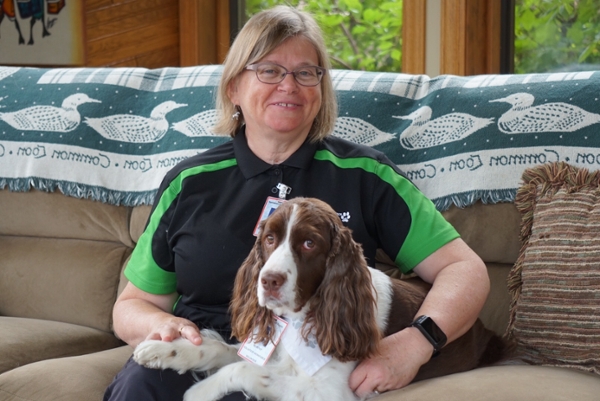
Paws-ing ER stress
Once a week Murphy visits the Royal University Hospital emergency room as part of a pilot project looking at the benefits of having a support animal in the ER
By Marg Sheridan
A trip to the emergency room can often be incredibly stressful for patients as well as their families. Waiting rooms, the constant movement of doctors, nurses and fellow patients, on top of the medical worry that brings people in to the hospital, can take a toll.
But a new pilot project at the Royal University Hospital (RUH) is helping provide patients with a little comfort in the form of an adorably friendly four-legged visitor: Murphy.
Murphy is a four-year old spaniel who is owned by the CoM’s dean and his wife, Jane Smith, who volunteers alongside the dog.
“Murphy loves it,” she said during a recent interview. “Murphy practically runs into the ER, he eagerly sits on the chairs and interacts with people – it is truly amazing to watch.”
And that eagerness has been indisputably beneficial to the project aimed at showing the benefits of having these animals visit the ER.
The project is self-select, which means that patients in the ER when Murphy visits are asked in advance whether they’d like a few moments with the dog before he’s brought into the room, and allows the team to ensure that those who don’t want to see him are accommodated.
“So far (the pilot) is just at RUH in the ER, and it’s only one day a week,” explained Dr. James Stempien, a Department of Emergency Medicine physician who is part of the team leading the project. “We’re gathering data both to show the safety, that there are no problems, and to show the benefits to the patients – so qualitative and quantitative.
“And once we’re done gathering our data, our plan is to publish the study, but also to show (it) to the (Saskatoon Health Region) and use that as a springboard to expand the services to the other ERs.”
The data is being collected by MD students, including fourth-year Lindsey Broberg, who is helping to curate it prior to publication – but that’s less of a job than it is an interest for Broberg.
“I’m a dog person – it must be written on my forehead,” Broberg laughed when asked how she became involved with the project. “The most overwhelming thing that I see consistently is just the impact that it has on people. They really rave about how much of a difference it makes in their stay, and the comparison between what our observers see before and after is really a shift in the focus from being sick to this focus on something outside of illness.”
It’s a reaction that Dr. Colleen Dell, a University of Saskatchewan sociologist working with the team, has seen to be the norm for people who are in stressful situations. Like Smith, Dell and her dogs have been working in the community with St. John Ambulance for several years.
“The human animal bond, no matter where we are, the thing that comes out the most is the sense of comfort and support that the animals provide,” Dell stressed. “The two goals of the St. John Ambulance therapy dogs are to provide love/comfort and support. And that’s what we measured in this project: they provide that space where they don’t judge, they don’t ask questions, and they encourage people to be with them in the moment.”
The results so far have been overwhelmingly positive, with each of the researchers involved sharing stories of patients who have reported lower pain ratings following even a short visit from Murphy.
“We know five minutes of petting your dog can reduce your stress hormones, increase the feel-good hormone oxytocin,” Dell explained. “There is solid research about that. There is also research that we’re finding the same things in the dogs as well, that they are in fact happier and they really like their jobs. It’s something that people don’t often talk about.”

And while patients are responding well to Murphy’s appearance in the emergency room, they aren’t necessarily the only ones.
“There was a lot of joking that it was hard to get Murphy onto the floor because usually the first visit would be to the nurses’ lounge and they didn’t want to let him go,” Stempien laughed. “It’s a stress reducer for everybody who interacts with Murphy. The physicians, and all our clinical staff, work hard and are under high levels of stress so it benefits them to visit with him.”
“The staff love the dog as much as the patients do, and it’s part of my mission,” Smith continued. “The mission is as much for the staff as it is for the patients, because it’s not exactly an un-stressful environment where they work, and it’s really quite heartwarming to watch the response of the nurses and the doctors.”
And Murphy is a consummate pro at this point. In addition to his weekly visit to RUH, he is a frequent guest at the Dubé Centre, a local seniors’ home, as well as the airport – all high-stress environments where his presence is a calming one. He has been such a great benefit to the Saskatoon community that in early December he’ll be awarded a St. John Ambulance Priory Vote of Thanks in Regina at the Lieutenant Governor’s residence, which recognizes his service, assistance and support to the Order of St. John in Canada.
It’s not likely to go to his head though, and the hope is that in the long run his work will pave the way to more canine visitors to the ER.
“Emergency medicine isn’t just about making the right diagnosis, though that’s obviously extremely important,” finished Stempien. “It’s about making our patients comfortable.”
And that’s what Murphy does best.
